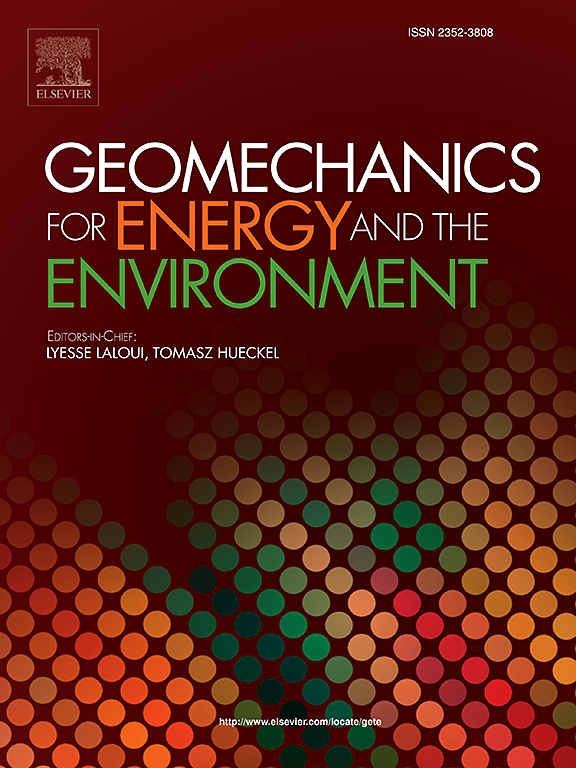Application of discrete element numerical simulation methods in mechanical characterization of hydrate-bearing sediments: Research status and challenges
IF 3.3
2区 工程技术
Q3 ENERGY & FUELS
引用次数: 0
Abstract
Natural gas hydrates, as a promising clean energy source, have garnered significant attention globally. A comprehensive understanding of the mechanical properties of hydrate-bearing sediments (HBS) and their evolution during hydrate decomposition is essential for ensuring sustainable, efficient, safe, and controllable hydrate exploitation. The macroscopic mechanical properties of HBS are controlled by the evolution of their internal microscopic structures. It is of great significance to clarify the evolution of the internal microscopic mechanical properties of HBS for an insightful understanding and a comprehensive evaluation of their mechanical properties. Therefore, it is discussed around the problems of micromechanical properties related to HBS in discrete element numerical simulation. A comprehensive review and summary of current research on micromechanical properties in HBS is presented, covering four key aspects: microscopic structural types, discrete element sampling methods, micromechanical properties, and hydrate decomposition microscopic multi-field coupled discrete element simulation. The paper briefly discusses the relationship between micromechanical structural types of HBS and the formation of reservoirs under varying geological conditions and gas environments. Additionally, it introduces the latest sampling methods and techniques for HBS with different hydrate morphologies in discrete element method (DEM) numerical simulation. The impact of diverse hydrate morphologies and saturations on the micromechanical properties of HBS is outlined. Recent advancements in studying hydrate decomposition microscopic multi-field coupling and its influence on the evolution of micromechanical properties in HBS are summarized. The paper delves into the internal relationship between the evolution of micromechanical properties and the macromechanical response of HBS. Finally, it discusses the current shortcomings and challenges in micromechanical property research of HBS and provides corresponding suggestions. This study aims to offer insights and directions for the DEM numerical simulation research on the micromechanical properties of HBS.
离散元数值模拟方法在含水沉积物力学表征中的应用:研究现状与挑战
天然气水合物作为一种前景广阔的清洁能源,在全球范围内受到了广泛关注。全面了解含水合物沉积物(HBS)的力学特性及其在水合物分解过程中的演化,对于确保水合物开采的可持续、高效、安全、可控至关重要。HBS的宏观力学性能受其内部微观组织演变的控制。阐明HBS内部微观力学性能的演变,对于深刻理解和全面评价其力学性能具有重要意义。因此,在离散元数值模拟中围绕与HBS相关的细观力学性能问题进行了探讨。本文从微观结构类型、离散元采样方法、微观力学性能、水合物分解微观多场耦合离散元模拟等四个方面对HBS微观力学性能的研究现状进行了综述和总结。本文简要讨论了不同地质条件和含气环境下HBS微观力学构造类型与储层形成的关系。此外,介绍了离散元法(DEM)数值模拟中不同水合物形态HBS的最新采样方法和技术。概述了不同水合物形态和饱和度对HBS微观力学性能的影响。综述了水合物分解微观多场耦合及其对HBS微观力学性能演化影响的研究进展。研究了HBS细观力学性能变化与宏观力学响应之间的内在关系。最后讨论了目前HBS细观力学性能研究存在的不足和面临的挑战,并提出了相应的建议。本研究旨在为HBS细观力学性能的DEM数值模拟研究提供思路和方向。
本文章由计算机程序翻译,如有差异,请以英文原文为准。
求助全文
约1分钟内获得全文
求助全文
来源期刊

Geomechanics for Energy and the Environment
Earth and Planetary Sciences-Geotechnical Engineering and Engineering Geology
CiteScore
5.90
自引率
11.80%
发文量
87
期刊介绍:
The aim of the Journal is to publish research results of the highest quality and of lasting importance on the subject of geomechanics, with the focus on applications to geological energy production and storage, and the interaction of soils and rocks with the natural and engineered environment. Special attention is given to concepts and developments of new energy geotechnologies that comprise intrinsic mechanisms protecting the environment against a potential engineering induced damage, hence warranting sustainable usage of energy resources.
The scope of the journal is broad, including fundamental concepts in geomechanics and mechanics of porous media, the experiments and analysis of novel phenomena and applications. Of special interest are issues resulting from coupling of particular physics, chemistry and biology of external forcings, as well as of pore fluid/gas and minerals to the solid mechanics of the medium skeleton and pore fluid mechanics. The multi-scale and inter-scale interactions between the phenomena and the behavior representations are also of particular interest. Contributions to general theoretical approach to these issues, but of potential reference to geomechanics in its context of energy and the environment are also most welcome.
 求助内容:
求助内容: 应助结果提醒方式:
应助结果提醒方式:


